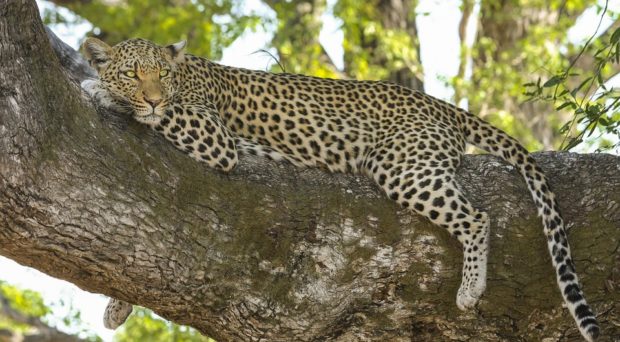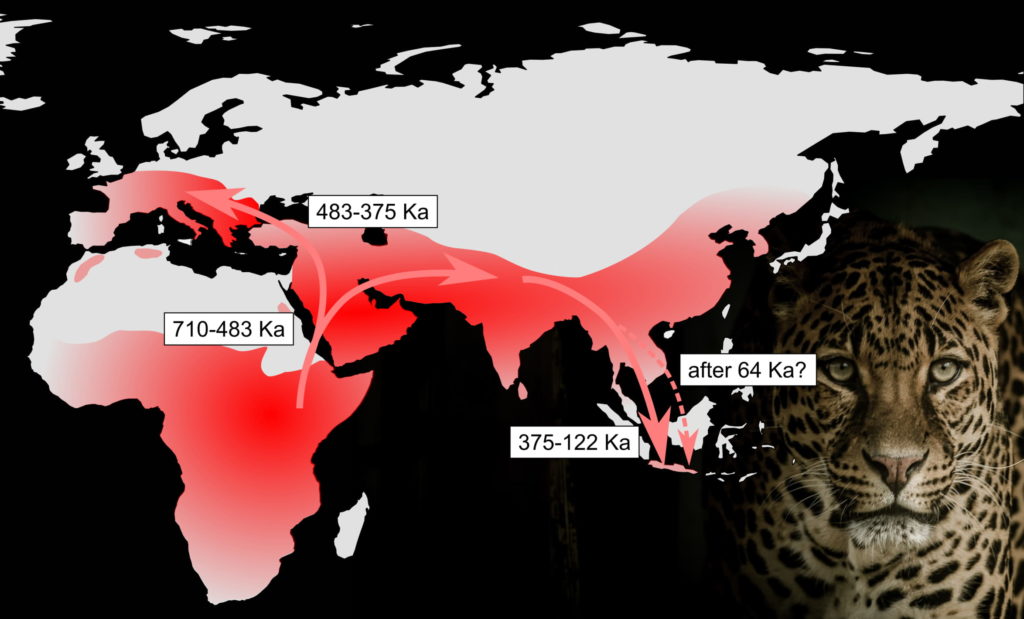
Leopards can’t change their spots, but they have changed the spots where they live…
Leopards (Panthera pardus) are large, iconic predators that are currently distributed over large parts of Africa and Asia. The Asian populations are believed to be descended from African leopards, founded in an out-of-Africa dispersal event (much like human history).
Based on fossil remains, we know that leopards were also present in Europe for most of the Pleistocene, but these European leopards went extinct some time during the last glacial period (~25,000 years ago). However, it has always been unclear how the extinct European leopards were related to leopards in Africa and Asia today.
European leopards share a more recent ancestor with Asian leopards than with African leopards, which suggests that the European population was founded in the same out-of-Africa migration that founded the Asian leopards.
We investigated ancient DNA samples derived from European “ice-age” leopards (some of which were up to 45,000 years old), as well as samples of Asian and African leopards from museum collections, to resolve questions regarding the relation between ancient and modern leopards and the biogeography of these iconic predators.
Biogeography involves the study of geographic distribution of lineages, and tries to infer the past processes that could have led to the observed patterns. For example, leopards lived in Europe until the end of the last glacial period, and the DNA from these extinct populations can tell us something about their origin, and how they are related to the leopards that live today.
The investigation of DNA from current populations may only reveal the genetic diversity that has survived in today’s leopards. Although challenging to work with, including DNA from ancient and historical samples can provide unique insights into the history and genetic diversity of a species. This is because it allows us to obtain information about lineages and populations that no longer exist today, like the European leopard.
Our analysis of ancient DNA sequences shows that European leopards share a more recent ancestor with Asian leopards than with African leopards, which suggests that the European population was founded in the same out-of-Africa migration that founded the Asian leopards.

Out-of-Africa: not the first and not the last
Our data provides further support for the hypothesized African origin of all living leopards. There are a number of other mammals for which an African origin has been proposed (e.g. hyenas, lions), including our very own ancestors.
We have used fossil-calibrated genetic methods to estimate the timing of the leopard out-of-Africa dispersal, and our results suggest it occurred between 710-483 thousand years ago. The genetic data for leopards also suggests that the out-of-Africa dispersal happened in a single event, rather than multiple, repeated events.
The timing of this event does not directly correlate with the dispersal of the earliest Hominids (Homo erectus, approx. 2 million years ago) or earliest anatomically modern humans (H. sapiens, approx. 100 thousand years ago), so it is likely that different processes drove the out-of-Africa dispersal events for each species.
Unexpected results from our Javan leopard

One of our leopard samples was reported to originate from Java, where leopards are assigned to a separate subspecies (the Javan leopard Panthera pardus melas). Previous studies found that DNA from Javan leopards was distinct from all mainland Asian leopards, suggesting that this population has been isolated in South East Asia for a long time. However, we found that the Javan leopard museum specimen is closely related to the Indochinese leopard, suggesting instead that there may have been a more recent genetic exchange between mainland and Javan leopards.
Although, of course, the results from a single sample should be treated with caution, they do urge for more detailed investigations of the Javan leopard and its relationship to the mainland populations.
Implications for modern leopards
We investigated mitochondrial DNA, which is only a small part of the genome and is only inherited through the female line. Thus, it only reveals a part of the evolutionary history of a species, and there can be multiple scenarios that lead to similar genetic patterns, making them difficult to distinguish. The unexpected result for the Javan leopard is a good example of the challenges associated with the formulation of conservation strategies.
Currently, the conservation efforts for the Javan leopard are based on its taxonomic status as a distinct subspecies. Our results could potentially point to more recent gene flow between the mainland and Java than was previously believed, which could have implications for leopard population management.
However, the current taxonomy is based on many more factors than mitochondrial DNA alone. More data needs to be collected in order to fully characterize the relationship between the Javan and the mainland leopard and how to best ensure their continued survival.
Comments